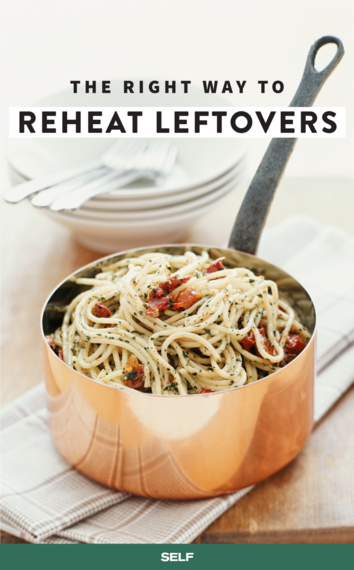Give those dishes a second shot.
For SELF, by Audrey Bruno.
Coming home to leftovers or pre-prepared freezer-meals is the best. Figuring out how to reheat them is not. While the microwave may seem like a great option, it can often leave you with soggy, strangely chewy food that vaguely tastes like it once had flavor.
"The method you use is really what can make or break the dish," explains Lauren Minchen, M.P.H., R.D.N., C.D.N., owner of Lauren Minchen Nutrition and Golda Bar.
So while the debate about heating up leftover pizza rages on (team microwave vs. oven lovin'), here are five simple tips that will help ensure you always get the most of out of your extra grub.
1. Fire up your oven.
When it comes to leftovers, the oven is your best friend. "Reheating food in the oven takes longer, but it usually keeps the original texture of the food intact," says Maxine Yeung, M.S., R.D.N., owner of The Wellness Whisk (and former pastry cook!). She likes to use the oven to reheat pasta, pizza, and especially vegetables, because she says, "it helps keep [their] crispiness." Of course reheating times will depend on your actual meal.
2. Use your stovetop, too.
While the oven is great for casseroles and veggies, Minchen suggests opting for your stovetop when it comes to stews and soups, or slow-cooker and skillet meals. "I find that [cooking them over] low heat can help preserve the taste and texture of the food," she says. Bonus: This method tends to be a lot faster than using an oven.
3. Cut large items, like lasagna, into smaller chunks.
A common reheating issue: when foods, like casseroles, warm unevenly, so it feels hot on the outside but is still cold on the inside explains Yeung. To remedy this, she recommends cutting whatever you're cooking into slices. This will, "speed up the reheating process and allow for even cooking," she says.
4. Try this easy trick to revive your grains.
We're all familiar with too-crunchy leftover rice. "Rice and grain dishes can be more difficult to heat because they harden when chilled, and heat often dries them out even more," says Yeung. But this common annoyance is easily solvable with a splash of water. Yeung explains that adding water will help soften your grains while you reheat them. She likes to add her rice to foil packs with the rest of her leftovers and reheat everything together.
5. And don't forget to defrost.
"I generally recommend not reheating something from its frozen state," says Minchen. If you pop a frozen casserole straight into the oven, this may cause it to become watery, which does not sound exceptionally satisfying. But hey, you gotta do what you gotta do.
To help avoid this, simply thaw out your frozen food before cooking by transferring your food from the freezer to the fridge up to a day in advance. "Reheating should ideally be done from a refrigerated temperature," she says.

